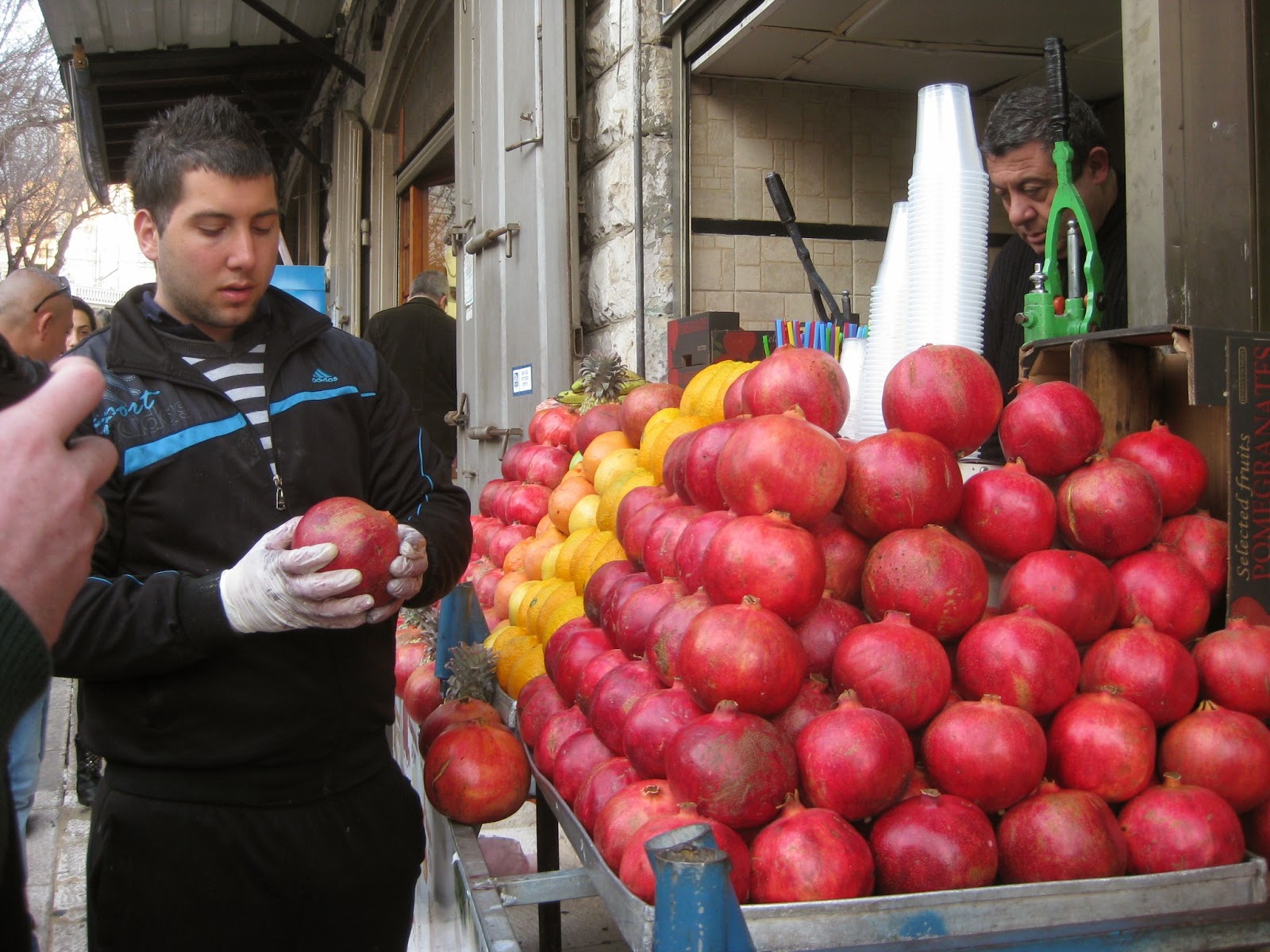 |
| Breakfast in Israel |
Day two in Israel started earlier than I'd hoped, like at about 4 AM. Because of the time change, most in our group awoke in the middle of the night and couldn't get back to sleep. The nice buffet breakfast at the Ramada Inn, Netanya, where we stayed, perked us up nicely, and we were ready for a busy day.
The Volvo bus left Netanya at 8:26 AM and headed up the Mediterranean coast to our first stop, Caesarea, located 31 miles north of Joppa, along the Mediterranean shores. The ruins of Herod's city are amazingly preserved.
 |
| Red lines mark the bus route. Green lines mark national borders. |
Caesarea was a port city, built by King Herod the Great, who ruled Israel from 37 BC until his death during Jesus' childhood. Herod was responsible for the heinous "slaughter of the innocents" when he ordered the deaths of all boys under age two in Bethlehem and the surrounding area. He did this in an attempt to kill the newly born "king" of Israel, later known as Jesus Christ, who posed a threat to Herod. Herod was known as a ruthless dictator who even killed members of his own family.
On the upside, Herod was known as a master builder, who authorized the construction of several grand, state-of-the-art projects, based on Roman architectural style. Caesarea was perhaps Herod's most lavish project, showcasing all that is Roman, including a royal palace, theater, amphitheater, hippodrome (stadium/arena), temple, man-made harbor, and a 6-mile aqueduct.
 |
| Roman statue in Caesarea |
 |
| Pastor Paul Glazner talks in Caesarea's Roman theater |
 |
| A not-so-private bathroom by the hippodrome (stadium) |
In the Bible, Caesarea is where the first Gentiles (non-Jews) are specifically mentioned as converting to Christianity. The Roman centurion Cornelius and several other Gentiles were led to Christ by Peter. “While Peter was still saying these things, the Holy Spirit fell on all who heard the word. And the believers from among the circumcised who had come with Peter were amazed, because the gift of the Holy Spirit was poured out even on the Gentiles.” (Acts 10:44-45 ESV).
Our next stop was Megiddo, a historically strategic hill, layered with the remains of about 20 ancient civilizations.
King Ahab (one of Israel's ancient kings) built a tunnel that goes straight down from the top of the mountain to the bottom. It enabled ancient Israel to smuggle water from a spring up to the high fortress.
Megiddo overlooks the Jezreel Valley, also known as the Valley of Armageddon, where the final battle on earth will occur. This is mentioned in Revelation 16:14, 16 -- “For they are demonic spirits, performing signs, who go abroad to the kings of the whole world, to assemble them for battle on the great day of God the Almighty…. And they assembled them at the place that in Hebrew is called Armageddon.”
Then we visited Mt. Carmel, where, in 1 Kings 18, the prophet Elijah faced off the false prophets of Baal.
Our next stop was Zippori, the capital of Galilee during the rule of Herod Antipas (son of Herod the Great) in the early 1st century, the time of Christ. Incredible Roman architecture, along with elaborate mosaics, characterized the city from Roman times through the early Byzantine (beginning 330 A.D.) era. The Mona Lisa of Galilee (pictured at bottom) is part of a large mosaic floor in a Roman villa known as the Dionysus (god of wine) house, built in the early 3rd century.
 |
| Herod's fresh-water aqueduct in Caesarea: 6-miles long |
 |
| Stop for lunch: falafel and chicken |
 |
| Valley of Armageddon in view from top of Mt. Megiddo |
Our final stop was in Nazareth, where Jesus spent most of his childhood. A quick biblical reference: “…they [Joseph, Mary and the child Jesus] returned into Galilee, to their own town of Nazareth. And the child grew and became strong, filled with wisdom. And the favor of God was upon him.” (Luke 2:39-40 ESV).
Today, Nazareth is part of the Palestinian West Bank. It is a busy, crowded city, of a largely Arabic population. Since the actual stomping grounds of Jesus are buried several layers below today's city, I couldn't get any sense or feel of ancient Nazareth.
The Church of the Annunciation (in Nazareth), built in 1969 over the ruins of previous shrines, is built over the spot where, according to Catholic tradition, the angel Gabriel announced to Mary that she would give birth to the Messiah. The first shrine was built in the 4th century. “And behold, you will conceive in your womb and bear a son, and you shall call his name Jesus. He will be great and will be called the Son of the Most High.” (Luke 1:30-32 ESV).
As the day drew to a close, we drove to the Leonardo Club Hotel in Tiberias, overlooking the Sea of Galilee. We ate a relaxing buffet dinner and looked forward to the next day's boat ride on the sea where Jesus walked on water.
 |
King Ahab's tunnel down through Mt. Megiddo
|
 |
| Nazareth pomegranates |
 |
| Church of the Annunciation in Nazareth |
 |
| Mary with Christ: Church of the Annunciation |
 |
| Amazing ancient ruins in Zippori |
 |
| The Mona Lisa of Galilee (3rd century AD) mosaic in Zippori |














You really took great photos on this trip too, Tom. Really makes me wish I could go over there.
ReplyDelete